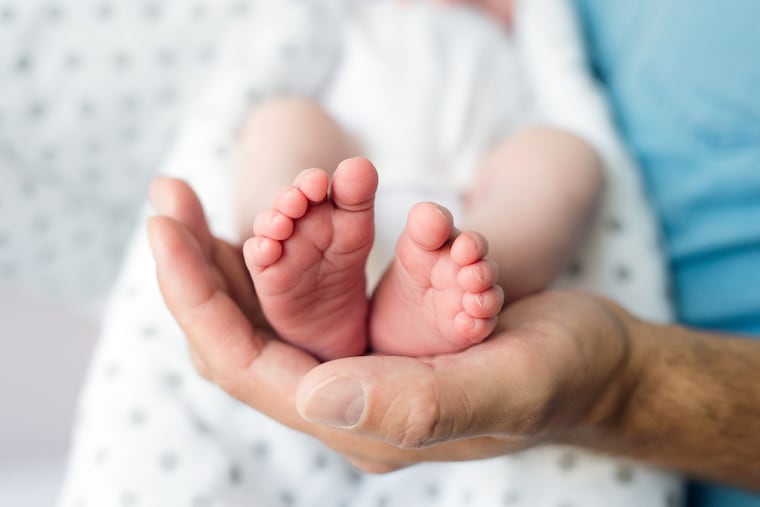Medical mystery: An unusual rash on newborn’s feet
I looked very closely at these unusual, circular, purplish lesions, then listened very closely to the baby's heart knowing that what I thought she might have could cause heart failure, and even death.

I have been an academic general pediatrician for almost two decades. Our hospital hasn’t had a dermatologist in that time so, for the last decade, I have taken on the role of developing a dermatology curriculum for our doctors to ensure that they are prepared to diagnose, treat and sometimes refer, common and uncommon pediatric skin conditions.
It is very common for me to get a page (yes, I still have a pager) to look at a skin condition on which a colleague might need an opinion, so it wasn’t a surprise that I was called to our newborn program to look at a 2-week-old with an unusual rash on her feet.
The baby was born full term with no complications and she was growing like a champ. The only concern her mother had was four or five mildly purplish circular lesions on the soles of her daughter’s feet that were a bit scaly. The rest of her physical exam was perfect.
The possible diagnoses for feet rashes are pretty narrow, and my colleague thought that it might be scabies — a microscopic insect that has a predilection for hands and feet. But that diagnosis would be quite unusual in a newborn, especially without anyone else in the family exhibiting symptoms.
“Could it be eczema?” my colleague asked.
“Wrong location,” I said. Eczema in infants usually starts on the face.
“Could it be irritation from infant shoes or socks?” she asked. Not likely.
Sometimes congenital syphilis can present with rashes of the extremities, but the mother’s labs were all normal. The baby’s rash also looked similar to an unusual rash called granuloma annulare, but it almost always is found on the top of the foot and/or hands, which this was not.
I looked very closely at these unusual, circular, purplish lesions, then listened very closely to her heart, knowing that what I thought she might have, if not investigated further, could cause heart failure, and even death.
Solution:
In December 1954, a case report was published in the Archives of Dermatology and Syphilology describing an infant born with a few small bumps on the face that progressed until he was seen by a dermatologist at 6 weeks of age with a few dozen lesions some up to 1 inch in size on the face and in the scalp. The physician followed this child’s rash, which started to subside on its own, until 11 months of age, when his mother was diagnosed with an autoimmune disease that tied together the mystery of this infant’s rash.
His mother was diagnosed with systemic lupus erythematosus, or SLE for short. Her son was then diagnosed with neonatal lupus erythematosus or NLE.
SLE is one of the most common autoimmune diseases in the world. People with SLE have autoantibodies that attack their own tissues and cells instead of what they were evolved to do, which is fight off infections. Symptoms of SLE can range from various skin manifestations to kidney failure and heat failure. SLE is a lifelong condition that affects women more than men, and symptoms over time can wax and wane.
NLE is much less common and occurs in 1 out of 20,000 lives births. NLE occurs when the mother’s autoantibodies cross the placenta and damage the developing fetus. The most common symptom of NLE is a rash, such as the one our patient had. This can be present at birth but can also develop in the first few weeks of life. The rash typically is circular, as on our infant, but occurs much more commonly on the face. It can also cause a rash around the eyes called “racoon eyes.”
The second most common symptom, and the most feared, is heart problems that can cause an infant to have a slow heart rate, or if not diagnosed and treated with a pacemaker, no heartbeat at all. Other symptoms can include problems with the liver, brain and even blood cells. Thankfully, NLE usually resolves once the mother’s antibodies leave the infant at about 4 to 6 months of age.
We tested the mother for SLE, which came back negative. But she did test positive for one of the most common autoantibodies, called anti-Ro. The baby also tested positive for these autoantibodies, which we identified as the cause of the “lupus-like” presentation in the baby and thus confirmed the diagnosis of NLE. An EKG on the baby was negative and the rest of her blood work was normal. Both the mother and infant followed up with rheumatologists to ensure that their disease would not progress.
At 9 months old, the only evidence of her diagnosis was small lesions on her face and feet that had no pigment in them and she was still growing like a champ. Children with NLE are at no risk of developing SLE later on, but her mother has to be monitored closely and subsequent pregnancies put those babies in much higher rates of developing NLE.
Daniel R. Taylor is an associate professor at Drexel University College of Medicine and director of community pediatrics and child advocacy at St. Christopher’s Hospital for Children.